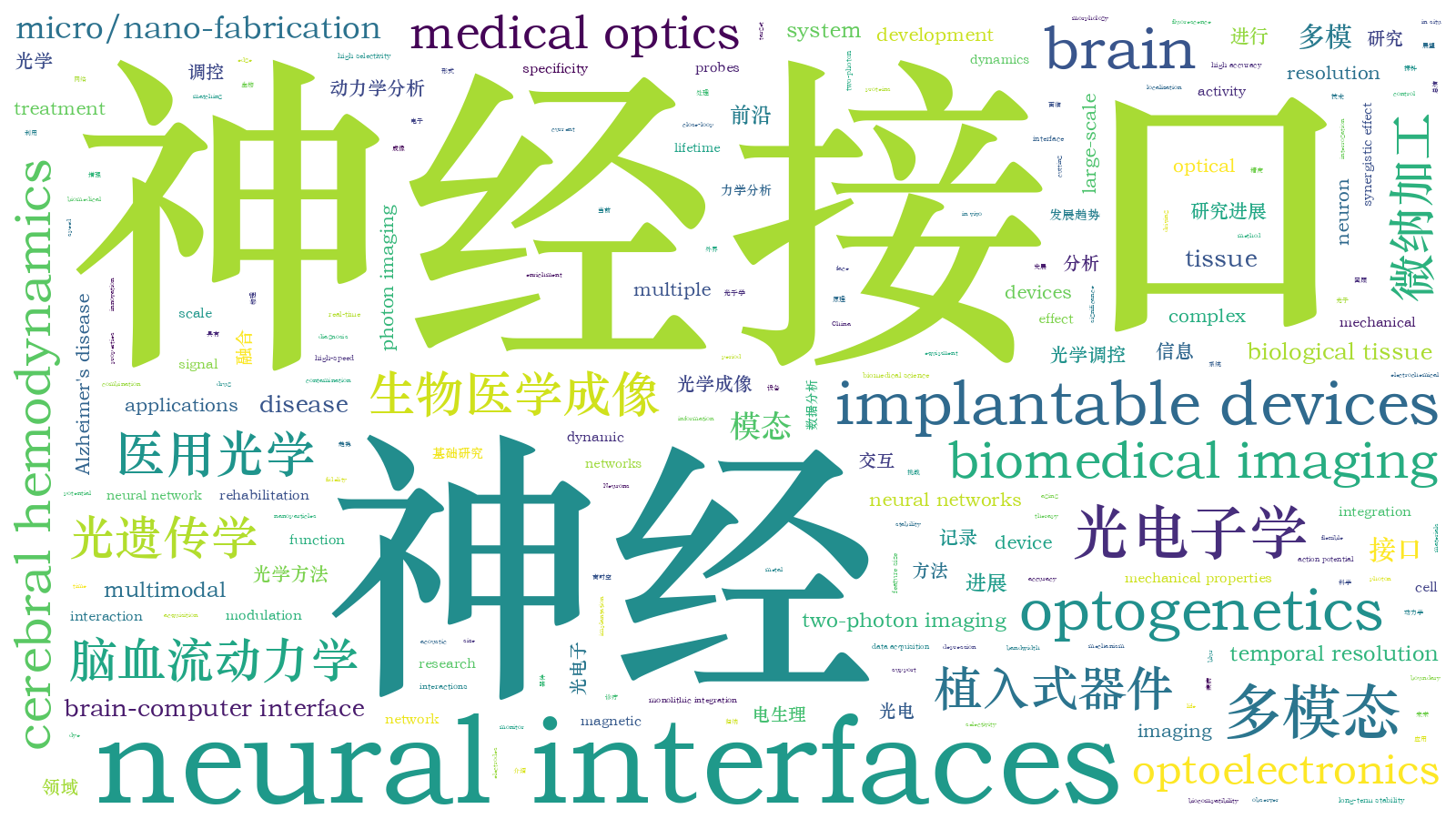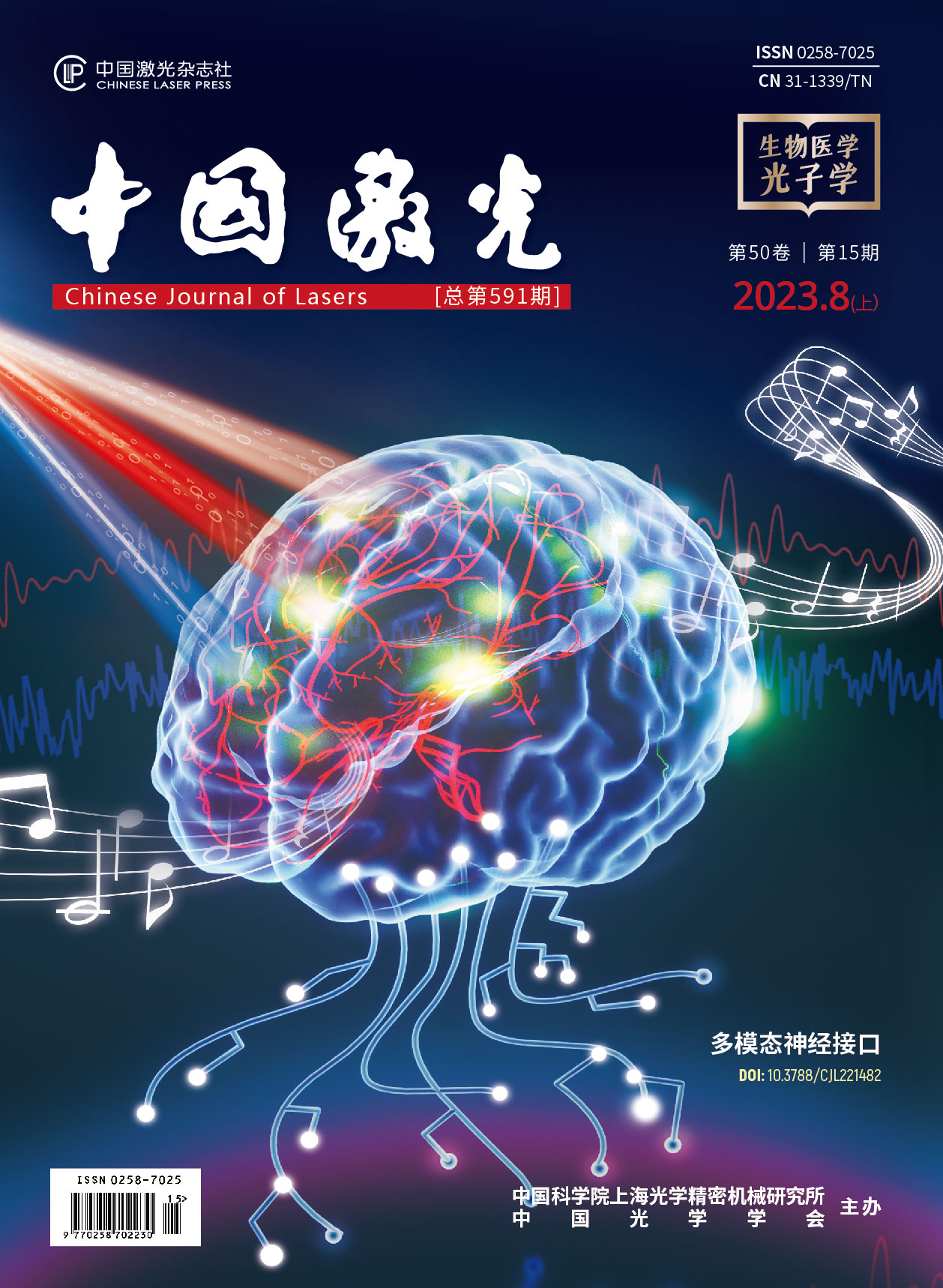植入式多模态神经接口前沿进展  下载: 1326次封面文章【增强内容出版】
下载: 1326次封面文章【增强内容出版】
The nervous system is composed of different types of neurons connected in a network. Neurons communicate with each other through electrochemical signals, and this dynamic interaction of neurons is the internal driving force of human perception, cognition, and behavior. Deciphering and understanding the meaning of various complex neural activities is of great significance in the frontiers of neurological disease diagnosis and treatment, neurological rehabilitation, fundamental brain science, and several brain-computer interface applications. To achieve this, it is critical to develop advanced neural interfaces capable of interacting with the dynamic neural activities and nervous system. Fundamental research in this field has rapidly increased over the past few decades as a result of advancements in neuroscience and neurotechnology. This research includes the development of innovative neural recording and modulation tools that have provided researchers with an early glimpse into previously unanswerable questions, such as determining how the mind works, or which have been recognized and funded by a host of initiatives. In recent years, the United States, European countries, Japan, and China have launched their own brain initiatives to support this emerging field. In the future, in order to completely understand the complex structural and functional nervous system, more powerful tools must be developed to record, transmit, and modulate signals using multiple approaches. These tools must have the ability to manipulate neuron cell types specifically while minimizing side effects such as “the observer effect.”
Neurological disorders affect more than one billion people worldwide, accounting for 7% of the total global disease burden, and this number is expected to increase substantially as human life expectancy increases and with increased population aging. This is largely due to neuropsychiatric diseases (including Alzheimer's disease, Parkinson's disease, epilepsy, and so on) and cerebrovascular diseases, which impose a heavy burden on society and individuals, while also promoting advances and developments in neuroengineering, biomedical science, and technology. Currently, the treatment of these diseases relies primarily on drug therapy or implantable electrical stimulation devices, such as injecting current into the target tissue through metal electrodes to activate or suppress the action potential of neurons, as well as to achieve therapeutic purposes, including using cochlear implants, deep brain stimulators, spinal cord electrical stimulation, and visual prostheses to reduce symptoms or restore nerve functions.
With the enrichment of multiple neural modalities, neural technologies and tools have been increasingly augmented, and have been widely used to collect neuron activities in vivo from individual neurons to neuron populations in different brain areas, with a variety of signal recording and modulation manners (Fig. 1). In addition, advances in genetic engineering, especially optogenetics, allow us to continuously control specific types of neurons with high accuracy and fidelity over a short period. The rapid development of genetically encoded neural probes provides new avenues for real-time and high-speed neural recording. Various optical, electrical, and chemical tools have been developed to record and modulate neural activities. Currently, the monolithic integration of multiple functional features has become a pressing demand and challenge in neural engineering, while flexible neural implants are expected to establish seamless integration with the soft biological tissue and achieve a high-bandwidth close-loop interaction with the nervous system. It will provide a powerful tool for identifying complex neural circuits, as well as diagnosing and treating neurological diseases. In order to more accurately understand the brain neural network and its working mechanism, and to treat neurological diseases with high selectivity, it is necessary to simultaneously monitor neural activities with high spatial and temporal resolution. The combination of electrophysiological and optical methods (for example, two-photon imaging and electrophysiological recording) can maximize the synergistic effect of the two methods, making up for the shortcomings of each method.
Implantable multimodal neural interfaces integrate these approaches by maximizing their benefits and efficacy, providing neuroscientists with new access to the brain and revolutionizing applications such as the treatment and rehabilitation of neurological diseases. In order to achieve this, we need to understand the various neurotechnologies individually, how they function, as well as how they work together. Implantable neural interfaces have already been successfully employed in the long-term stable interrogation of large-scale neural activities and clinically restoring sensorimotor function in disabilities. However, they are limited in the long run by poor biocompatibility, mechanical mismatches between the device and neural tissue, and the risk of chronic inflammatory reactions after implantation. In addition, traditional neural probes are limited by spatial and temporal resolution and scalabilities, and still face challenges in the study of large-scale neural networks in situ (Fig. 1). To this end, long-term stability is achieved by matching the mechanical properties of the implanted device with those of the internal biological tissue. High spatial and temporal resolution and even specificity can be obtained by reducing the feature size of implants and mimicking the structural morphology of neurons. Multimodal neural interfaces are currently emerging, in particular, a variety of clinical multimodal implantable devices have been developed to treat neurodegenerative diseases such as Parkinson's disease, epilepsy, and depression. However, traditional device designs, such as electrophysiological readout, fluorescence cell imaging, and the structural dynamics of the brain, may conflict with each other during different data acquisition processes. Severe electrophysiological signal contamination caused by photoelectric (magnetic) artifacts can also occur. Over the past decade, there have been efforts to address these challenges, and many excellent results have emerged regarding the latest advances in neural technologies and applications.
With the development of neural probe structures and materials, as well as the innovation of synthetic technologies for nanoparticles, dye molecules, and genetically encoded proteins, it is expected that neural technology will continue to be developed toward the limits of the lifetime, localization and specificity of neural recording and stimulation, and will eventually blur the boundary between living biological tissue and physical equipment and tools. These cutting-edge neural technologies, which combine advanced optical and nanoelectronic technologies, optogenetics, genetically encoded indicators, and acoustic and magnetic tools, provide us with unprecedented opportunities for new multimodal neural information interactions, with which powerful paradigms for multimodal inquiry of brain activity will be foreseen, and will even fundamentally alter how brain activity maps to the physical world.
徐明亮, 李芳媛, 刘岳圻, 张瑾慧, 师亚洲, 何飞. 植入式多模态神经接口前沿进展[J]. 中国激光, 2023, 50(15): 1507301. Mingliang Xu, Fangyuan Li, Yueqi Liu, Jinhui Zhang, Yazhou Shi, Fei He. Frontiers of Implantable Multimodal Neural Interfaces[J]. Chinese Journal of Lasers, 2023, 50(15): 1507301.







